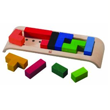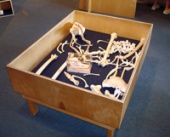How does parental help change children's approach to problem solving?

Parents and other adults often provide children with help while they are engaged in difficult tasks. However, little is known about what younger and older children do with that help (e.g. do they take the advice they are given by adults, or do they ignore it?). This study explored how young children solved a challenging puzzle when they work on it alone, and after they get help from a parent.
In this study, children worked on a wooden block puzzle that had many possible solutions. First, we asked children to work on the puzzle on their own. For half of the children, their parents were then allowed to provide whatever help they thought their child needed to solve the puzzle. For the other children, parents were asked sit on their hands while they offered their help – this allowed those parents to speak, but not gesture, to their children. Finally, all of the children worked on the puzzle on their own once more.
Our hypothesis was that older children would use problem-solving strategies that were more varied and more complex than younger children did. We also predicted that as children get older, they might use more of the information and advice they were given by their parents (from their words or their gestures) when they tried to solve the puzzle again on their own.
We found that children ages 3-4.5 years solved more of the puzzle the second time when their parents were allowed to gesture, compared to when their parents were only allowed to speak. It’s possible that for these children, the puzzle was challenging enough that they were almost able to solve it on their own, but not quite. The additional information from a parent’s gestures might give children at this age the help that they need to pick up new strategies for solving the puzzle. Children younger than 3, and older than 4.5, were equally successful whether or not their parent was allowed to use his or her hands. For children at these ages, the puzzle might be either too hard or too easy, and so the parent’s help might not influence children’s strategies.
Our results show that children between the ages of 3 and 4.5 might benefit the most from both observing their parents’ gestures and listening to their parents’ advice while solving problems, and that a parent’s gestures might be most helpful when children are attempting to solve problems just beyond their reach.
Resources:
Try it at the Museum

Puzzling Over the Mystery Skeleton
Help your child put together the Discovery Center’s Mystery Skeleton (ask a volunteer to help, if you need some clues). Notice how your child tries to put the skeleton together with the help of your, or a volunteer’s, suggestions.
What types of help does your child utilize the most? Does s/he incorporate strategies you verbally explained to her/him? How about strategies that you showed your child visually with your hands? Does your child’s puzzle solving strategy evolve as s/he receives different kinds of help?
Try it at Home
Do what I say, or do what I do…
Try helping your child put together a puzzle without using any words. Can you communicate using only gestures? What kinds of gestures are most helpful?
Now try helping using only words, and no gestures. Do you change your language in order to provide more information, or more specific instructions? What kinds of words do you use instead of pointing or gesturing?